
United States Store Catalogs: Sailor Suits (1921)
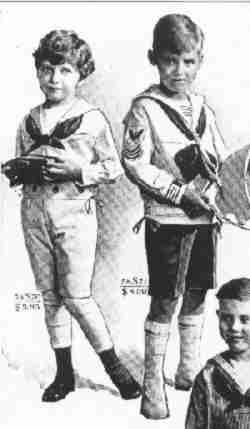
Figure 1.--The sailor suit on the left (s70) from a 1921 catalog
was made of unbleached jean for boys from 3 to 8 years. The French-blouse suit on the right (s71) was made of poplin for boys from 4 to 10 years. It had both blue and white short pants. The kneepants styles were only worn in the early 1920s and by mid-decade
had been replaced by short pants.
|
|
Here we see the variety of sailor suits offered for sale in store catalog in 1921. We believe these images come from the Atlman catalog, but are not positive as we have lost the reference material. We see boys' sailor suits here in a wide variety of styles. They seem especially popular for summerwear. The suits were also made in many materials. They were both play and dressy outfits. They were avilable in sizes up to about 10 years. Most of the sailor suits came with kneepants. We notice a few long pants suits, but no knicker or short pants suits.
Styles
Middy blouses
Middy blouses in America were still for boys in 1920. They were
were made in a wide variety of styles. Some of the terms used to
describe these suits I do not yet fully understand.
Button-on: Sailor suits for younger boys were made in the button-on
style. This mean buttons on the pants buttoned into button holes on
the middy blouse. The buttons were usually large white ones,
but there were black buttons as well. Examples: S70.
French blouse: Some middy blouses are described as "French blouse
style". I am not sure, however, what the distinctive features of this
style are. Examples: S71.
Tub suit: Some suits are described as tub suits. I am not sure
what that meant, perhaps that it could be easily laundred.
Regulation style: Several of the suits are described as regulatuion,
style presumably a reference to styling accurately reflecting U.S. Navy
uniforms.
Sleeves: Middy blouses had mostly been made with long sleeves,
even the white summer ones. In the 1920s, however, summer sailor
suits with short sleeves became more common. The short sleeves were
mostly elbow-length. Some eve had tight-fitting elbow cuffs.
Accessories: Sailor suits sod at better stories still commonly
fearured the scarf, lanyard, and whistle. By mid-decade sailor suits
were commonly sold without the scarves, especially the summer suits.
Most of the middy blouses appear to have a horizontal cut
left breast pocket. One suit has a vertical cut pocket (S91).
Sailor trousers
Short pants: Short pants had appeared in the 1900s, but did
not become commonly worn until the 1920s after World War I. By the
mid-1920s they had entirely replaced knee pants. Most sailor suits, especially white summer suits were worn with shorts.
Knee pants: Kneepants were going out of style, but several suits
came with kneepants (notice the buttons at the hem) rather than shorts. I though that dressy suits might be more likely to have kneepants, but
I can discern so consitent theme as to whether certain suits had
short pants or kneesocks.
Long pants: Very few suits offer long pants for boys. The one
suit that does (S75) also has a pair of shorts. One wonders who decided
which pair of trousers was worn for what occassions. The longs were
bell bottoms with laced strings in the back.
I can't tell if the trousers to these suits have pockets. The button-on
style trousers do not appear to have the pockets, but other 1920s styles
did. The middy blouses for the other suits
cover part of the trouser, so it is difficult to tell. But again other
1920s styles did, so these sailor suit trousers probably did also.
Dickies
The dickies in these sailor suits mostly appear to come with various
arrangements of stripes. Three narrow stripes appear the most common,
but several have bold stripes as well.
Accessories
The most popular accessories with sailor suits, besides the required
headgear, were ties, lanyards, and whistles. The ties were mostly
black silk. Even on the dark-colored suits, black ties were used. The
whistles were usually brass, held on by a lanyard. The boys liked the
whistles. Some mothers didn't and had them disabled so they would
make a noise.
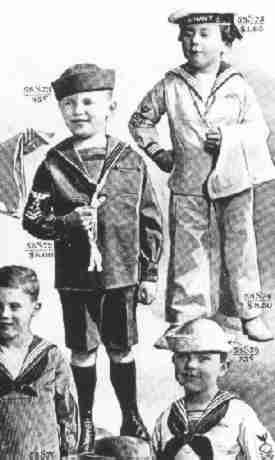
Figure 2.--The sailor suit on the left (S72) from a 1921 catalog
was made of khaki drill for boys from 3 to 10 years. He wears a "naval" cap (s73) to match. The suit on the right (S74) is in "regulation" middy style. It is white galatea with both long and short trousers for boys from 3 to 10 years. Note the Tam O'Shanter cap (S75)
|
|
Caps and Hats
The caps and hats worn with sailor suits had changed significantly
by 1920s. The wide brimmed hat with trailing streemer and elastic chin
strap, once a boys stapple is no longer seen. The caps are now smaller
and the swabbie-type cap more common.
Tam O'Shanter (S75): The Tam O'Shanter cap is still available, but it
is going out of style as the Navy has replaced it with the swabbie cap.
Notice the small streemer.
Brimmed cap: The boy wearing suit 79 wears a full brimmed straw
sailor
hat, but it is not offered for sale, an indication that the style was
going out of style. The versin shown, however, has a much smaller
brim than the ons once worn by boys.
Swabbie caps (S73 and 78): I'm not sure what the poroper name is
for this cap. It is the style worn by American sailors and was
rapidly replacing all the other types of sailor caps worn by American
boys. Most were white, but colored caps were also available.
Hair styles
American boys no longer wore long hair and curls. Some of the younger
boys had long hair, but usually not completely covering the ears. Most
boys in sailor suits had short boyish hair cuts.
Materials
Quite a wide range of materials were used for boys' sailor suits. This
was in part some were dressy outfits, but plau suits were becoming
popular.
Chambray: One suit (S77)has the collar and cuffs made of blue
chambray. Another suit for younger boys is made of brown chambray.
Cotton: Most of the blue and white stripped suit were made of
cotton.
Drill:
Drill came in several colors, white as well as a dark
khaki.
Galatea: I'm not sure yet just what galatea is, but am looking into
it.
Jean: I believe this means denim. Some suits indicate that they
were made from unbleaced jean (S70).
Poplin:
Silk: The sailor ties were usually black silk.
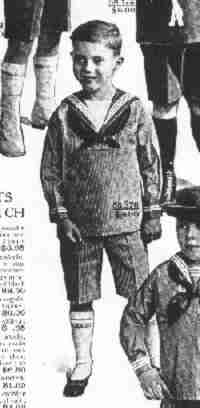
Figure 3.--This middy suit from a 1921 catalog was made in blue
and white striped cotton.
Interestingly while this is more of a practical play suit, the boy is
pictured in white kneesocks and patent-leather pumps with ribbons.
|
|
Colors
Sailor suits were made in both white and various shades of blue. They
were mostly worn with middy blouse and shorts of the same color. A few
were worn with white middy blouse and blue shorts, but never blue
middy blouse and white shorts. One suit was made in dark khaki (S72). I think this was uniquely America. I don't know of any European sailor suits that were khaki.
Ages
Little boys by 1920 were now wearing sailor suits as young as age 3. Just a few years, before World War I (1914-18) earlier many of these younger boys would have still been wearing dresses. The custom of keeping little boys in dresses, however, declined sharply in the 1910s--especially after the war. Several of the suits are made only in sizes to 7 or 8 while others
in sizes to 10 years. One of the major characteristic of the suits for
younger boys are that they are in the "button-on" style (S70, 89, 91,
and 92). The suits for younger boys are also the ones that differ the
most from regulation styling. Sailor suits were generally made in
sizes up to about 10 years. Older American boys did not wear sailor suits,
although older European boys did.
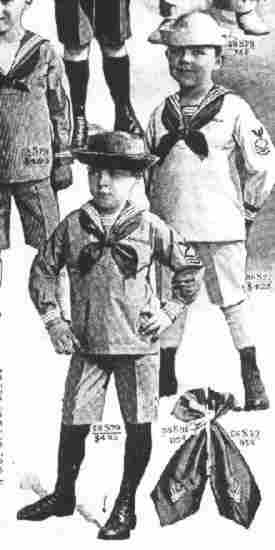
Figure 4.--These two boys in a 1921 catalog wear suits modely closely to the U.S, naval uniform, except for the bottom boys cap. The white suit (S77) is made of white drill for boys up to 10. The Belgian blue suit (S79) is for boys up to 8 in linen-finished suiting..
|
|
Shoes
Boys in 1920 wore quite a variety of shoes. Younger boys wore strap
shoes or pumps without the strap. Most of the younger boys wore high
top lace up shoes. One boy wears low-cut Oxfords, but he is a distinct
minority.
Socks and Stockings
American boys in 1920 wore sailor suits with both kneesocks and long
stockings.
Kneesocks: Kneesocks appear to b most commonly worn with short
pants sailor suits. Both white and dark kneesocks are worn with various
colored suits with no clear pattern. Some of the kneesocks are
solid colors, some have a colored or patterned band, usually near the
top of the sock.
Long stockings: Several suits are worn with both white and black
long stockings. The long stockings seem to be more common with the kneepants
than the short pants.
Individual Suits
The fashionable New York store B. Altman in 1921 provided
the following details of the summer sailor suits they offered for boys:
S70: Suit of unbleached jean, smartly trimmed with black silk tie,
black lacing and buttons; a practical tub suit; sizes 3 to 8 years. $3.95
S71: Suit in the French blouse style, and supplied with one pair
of trousers in blue mercerized poplin and one pair of trousers in white
galatea; the blouse is of white galatea; white braid; embroidered emblem;
tie of black silk; sizes 4 to 10 years. $8.50
S72: Suit in dark khaki drill in regulation middy style; trimmed with
black taping; excellently tailored; sizes 3 to 10 years. $6.00
S74: Suit in regulation middy style, supplied with one pair of
long trousers made exactly like a sailor's trousers with laced back and broad
front fall (bell bottoms); also one pair of short trousers; material in
white galatea; sizes 3 to 10 years. $8.50.
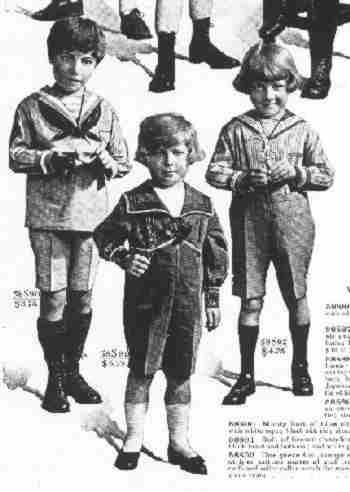
Figure 6.--The blue chambray suit (S90) on the left is for boys up to 10 years. The middle boy's brown suit (S91) of chambray is for a boy up to 7 years. The blue and white stripped suit on the right (S92) is for a boy up to 8 years old, with a cotton middy blouse and chambray kneepants. These styles come from a 1921 catalog.
|
|
S76: Middy suit of blue and white woven stripped cotton; a very
practical suit; black silk tie; sizes 3 to 10 years. $4.00
S77: Middy suit of white drill; tailored by uniform tailors; the material
is the regulation drill; the insignia and the tping cairred out in
regulation style; double yoke back and front; black silk tie; collar and
cuffs of blue chambray; braid trimmed, sizes 3 to 10 years. $4.25
S79: Middy suit of excellent quality linnen finished suiting, in
Belgian blue; an unusually well tailored suit, made in the regulation
style, with white tape, insignia on sleeve, black silk tie, and double yoke back and front;
sizes 3 to 8 years. $4.95
S89: Suit of light-weight khaki jean, in an attractive style; blavk
buttons and black silk style; sizes 3 to 8 years. $3.95
S90: Middy suit of blue chambray; collar, cuffs and shied trimmed
with white tape; black silk tie; sizes 3 to 10 years. $3.75
S91: Suit of brown chambry, in a very attractive style, trimmed
with black braid and buttons; and whit piping; sizes 3 to 7 years. $5.75
S92: One piece suit comprising blouse of blue and white woven
stripped cotton material and trousers of blue-mixed chambray; the cuffs
and sailor collar match the trousers, and the blouse is laced in front;
sizes 3 to 8 years. $4.75
HBC

Other Boys' Historical Clothing Web Site Related Pages:
[Sailor suits]
[Kilts]
[Smocks]
[Pinafores]
[Sailor Hats]
[Blouses]
[Ring Bearers]
[Long hair]
[Ringlet curls]
[Hair bows]
[Bangs]
[Collars]
[Bows]
Navigate the Boys' Historical Clothing Web Site:
[Return to the Main U.S. 1921 catalog page]
[Return to the Main 1920s sailor suit page]
[Introduction]
[Activities]
[Biographies]
[Chronology]
[Cloth and textiles]
[Clothing styles]
[Countries]
[Topics]
[Bibliographies]
[Contributions]
[FAQs]
[Glossaries]
[Satellite sites]
[Tools]
[Boys' Clothing Home]
Created: November 27, 1998
Last updated: 2:36 AM 11/6/2018







